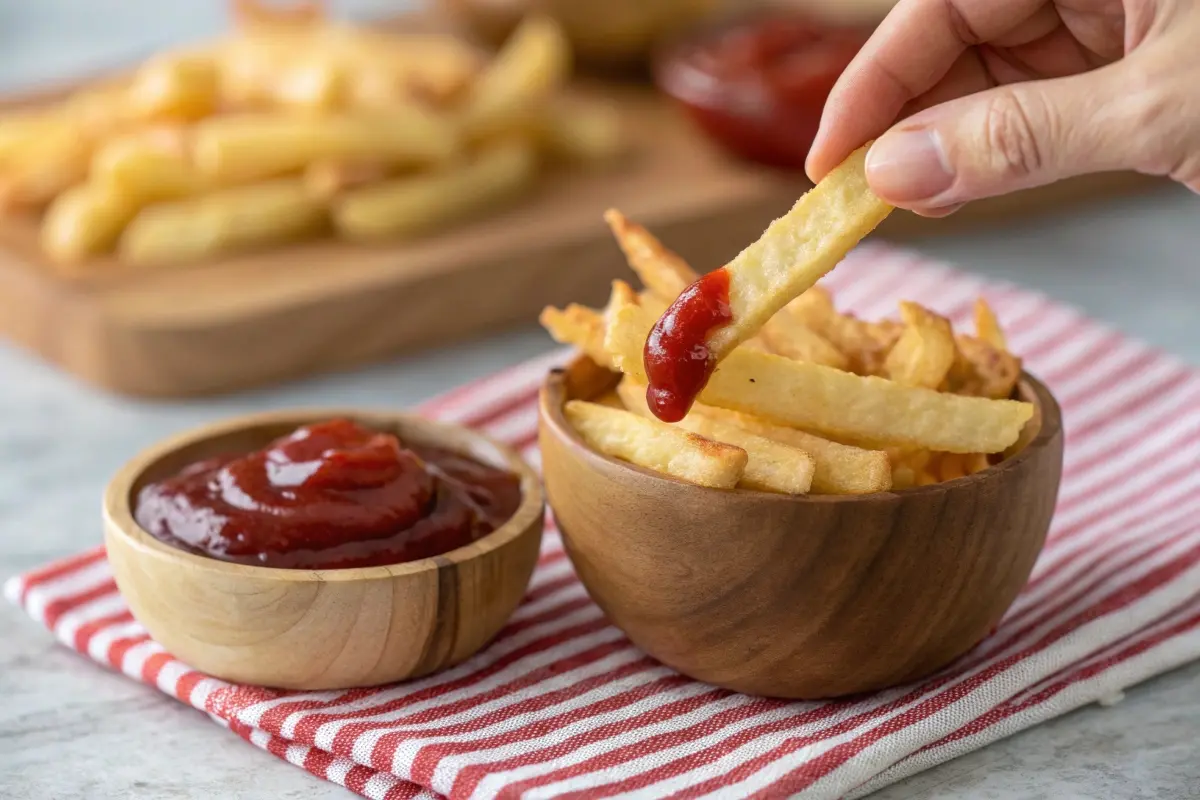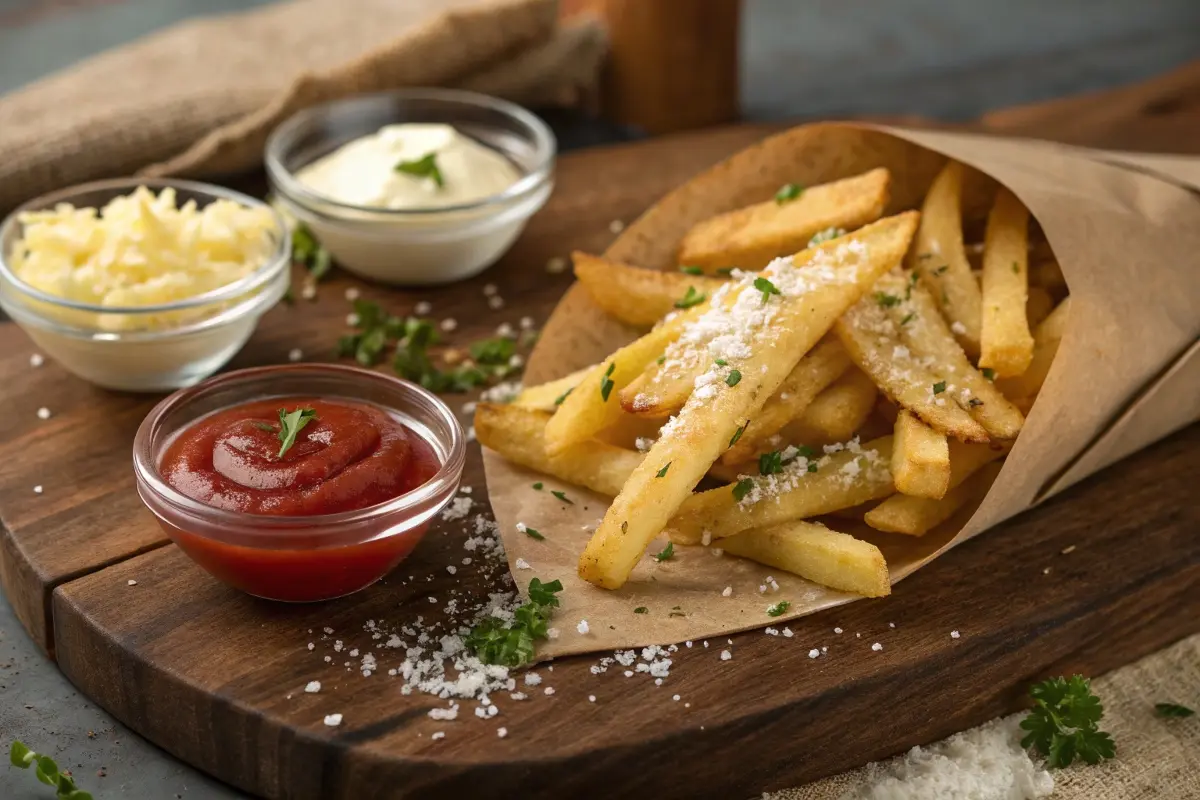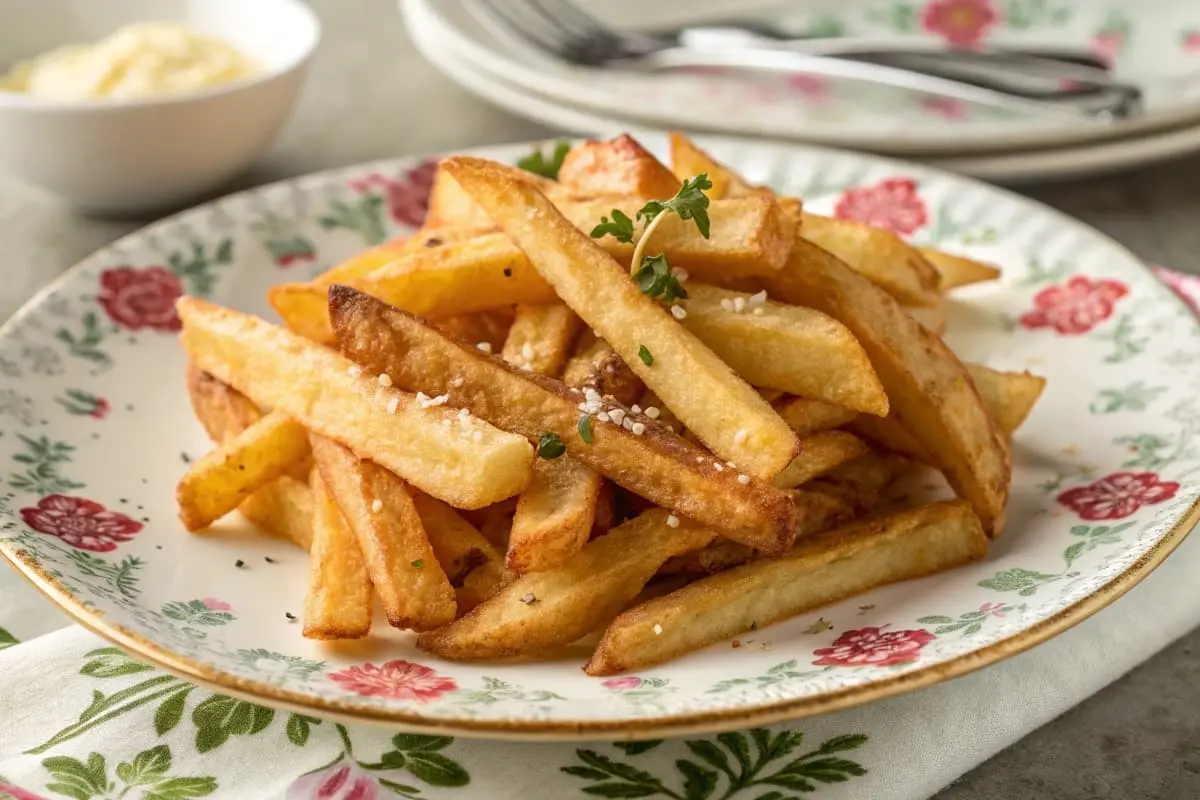Have you ever wondered, what language is papas fritas? This seemingly simple phrase carries with it layers of cultural, linguistic, and culinary significance. Rooted in the Spanish language, “papas fritas” translates to “fried potatoes” but represents much more than that. It’s a global comfort food that bridges cultures and delights taste buds everywhere.

Understanding the Phrase “Papas Fritas”
The Origin of the Term “Papas Fritas”
The phrase “papas fritas” originates from Spanish, where “papas” translates to “potatoes” and “fritas” means “fried.” Essentially, the term describes a dish that’s universally loved: fried potatoes! But its origins go beyond mere translation. It comes from the rich culinary traditions of Latin America and Spain, where potatoes, native to South America, became a staple.
Potatoes were first cultivated in the Andean regions of modern-day Peru and Bolivia. When Spanish explorers arrived in the Americas, they brought these golden tubers back to Europe, introducing them to new cuisines. The term “papas,” derived from the Quechua word, highlights its indigenous roots. So, when we say “papas fritas,” we’re nodding to history, culture, and flavor in every bite.
“Food is a language everyone understands, and ‘papas fritas’ speaks directly to the heart and stomach.” 🍟
Translation and Meaning of “Papas Fritas”
In English, “papas fritas” simply means “fried potatoes.” Sounds basic, right? But the phrase carries a lot more weight in Spanish-speaking countries. Unlike “French fries,” which is a generic term often associated with fast food, “papas fritas” reflects a more home-style, wholesome interpretation. Think of a grandmother frying up crispy, golden potatoes in her rustic kitchen — that’s the vibe.
The Cultural Significance of “Papas Fritas”
Culinary Role in Spanish-Speaking Countries
In Latin American and Spanish households, “papas fritas” aren’t just a side dish; they’re a way of life. From Argentine parillas (grills) to Colombian street carts, you’ll find papas fritas paired with everything — steak, chicken, fried eggs, or even on their own with a generous sprinkle of salt and a squeeze of lime.
In Peru, a country celebrated as the birthplace of the potato, “papas fritas” often accompany traditional dishes like lomo saltado, a stir-fried beef dish. It’s comfort food at its best.
Global Adaptation of the Dish
While “papas fritas” are rooted in Spanish, the concept of fried potatoes transcends borders. From British “chips” to Belgian frites, variations of this dish exist worldwide. Yet, the Spanish name carries a warmth that feels distinct. It’s more than just a term; it’s an experience steeped in tradition.
The Language Behind “Papas Fritas”
Spanish as the Root Language
It’s crystal clear: the phrase “papas fritas” is Spanish. But did you know that Spanish itself has many regional dialects and nuances? For instance, in Spain, some regions might use “patatas fritas” instead of “papas fritas,” showing how language adapts to local preferences.
Influence of Regional Dialects
In Mexico, you’ll hear “papas fritas” at every corner taco stand or casual diner. In Argentina, the pronunciation may take on a smoother, melodic tone, with locals saying it in a way that almost feels like a song. Language evolves, and so does its connection to food.
Similar Phrases in Other Languages
French Fries: The English Counterpart
In English, the term “French fries” is most commonly used to describe fried potatoes. However, the French origin is debated. Some believe the term originated in Belgium, where frying potatoes is an art form.
Other Regional Variations and Terms
In French, the dish is called pommes frites, while Italians might refer to it as patate fritte. Each variation reflects the unique flair of its culture, but the essence remains the same: crispy, golden deliciousness.
How “Papas Fritas” Differs from Similar Dishes
French Fries vs. Papas Fritas
While they seem similar, “papas fritas” and “French fries” often differ in preparation and context. Papas fritas are typically thicker, cooked in smaller batches, and sometimes fried in olive oil for a richer flavor. They’re more rustic, often served with homemade dips or sauces rather than commercial ketchup.
Influence of Preparation Techniques
The method of cooking can make or break a dish. In Spanish-speaking countries, the focus on high-quality ingredients and techniques ensures that papas fritas shine as a standalone dish, not just a sidekick.

Popular Dishes Featuring “Papas Fritas”
Classic Combinations in Latin American Cuisine
Latin American cuisine has embraced “papas fritas” as a versatile side dish, pairing them with bold, flavorful meals. In Argentina, for instance, they complement milanesa, a breaded meat cutlet that’s both crispy and comforting. Meanwhile, in Chile, dishes like churrasco sandwiches showcase “papas fritas” alongside layers of juicy steak, avocado, tomato, and mayonnaise.
For Colombians, these golden delights shine when topped with shredded cheese and served alongside roasted meats. In Peru, they play a starring role as an essential side for pollo a la brasa, the country’s beloved rotisserie chicken.
“Papas fritas can turn any meal into a celebration, offering a crispy canvas for the most vibrant flavors.” 🎉
Creative Recipes Incorporating “Papas Fritas”
Beyond traditional pairings, “papas fritas” have inspired creative twists in modern cuisine. From loaded fries topped with pulled pork and melted cheese to spicy versions tossed with chili powder and lime, the possibilities are endless. Fancy a fusion? Try a Mexican-inspired take with a drizzle of chipotle mayo and a sprinkle of cotija cheese.
Common Problems with “Papas Fritas” Preparation
Achieving the Perfect Texture
Let’s face it: not all fries are created equal. One of the most common issues is soggy fries. Nobody likes limp, greasy potatoes, right? Achieving the perfect crispiness often comes down to choosing the right type of potato (Russet or Yukon Gold), using the proper oil, and maintaining the ideal frying temperature (around 325°F to 375°F).
Ensuring Proper Flavor Balance
Another problem? Bland fries. Without the right seasoning, “papas fritas” can fall flat. A sprinkle of salt immediately after frying is non-negotiable, but why stop there? Experiment with garlic powder, smoked paprika, or even a dash of truffle oil for an elevated flavor profile.
Solutions to Elevate “Papas Fritas” at Home
Tips for Crispier Results
Want fries so crispy you can hear the crunch? Follow these simple tips:
- Double-fry them: The first fry cooks the potato; the second fry adds crispiness.
- Soak in cold water: This removes excess starch, which can cause sogginess.
- Use high-quality oil: Peanut or sunflower oil works wonders.
Pro Tip: Always dry the potatoes thoroughly before frying to avoid oil splatter.
Seasoning Ideas for Unique Twists
Take your fries to the next level with creative seasonings. Try Cajun spice for a kick or parmesan and parsley for a gourmet touch. Feeling adventurous? Sprinkle cinnamon sugar for a dessert-style twist! 🍠
Recipe: Classic “Papas Fritas”
Ingredients
| Ingredient | Quantity |
|---|---|
| Potatoes (Russet) | 4 large |
| Oil for frying | Enough to submerge |
| Salt | To taste |
| Optional: Seasonings | Paprika, garlic powder, etc. |
Preparation Method
- Peel and cut the potatoes into even strips. Soak them in cold water for at least 30 minutes.
- Heat oil in a deep fryer or pot to 325°F. Pat the potatoes dry and fry them in batches for 3–4 minutes until they’re soft but not browned. Remove and drain.
- Increase the oil temperature to 375°F. Fry the potatoes again until golden and crispy.
- Sprinkle with salt and your choice of seasonings while hot. Serve immediately and enjoy!
Fun Facts About “Papas Fritas”
- Did you know the world’s largest serving of fries was over 1,500 pounds? It happened in Egypt in 2015! 🏆
- Despite the name, French fries are likely Belgian in origin, not French. Talk about a mix-up!
- The average American eats about 30 pounds of fries every year. That’s a lot of potatoes!
What Language Is Papas Fritas?
“Papas fritas” — just saying the words can make your mouth water. But have you ever wondered what language this phrase belongs to or why it feels so familiar? Whether you’re dining at a Latin American restaurant or hearing it in casual conversation, “papas fritas” is more than just food; it’s a gateway into history, culture, and language.
The Language Behind “Papas Fritas”
Spanish as the Root Language
It’s no surprise that “papas fritas” belongs to the Spanish language, but the term itself offers a glimpse into how language and culture intertwine. Spanish, one of the most widely spoken languages in the world, reflects the culinary practices of its speakers. Words like “fritas” reveal the importance of frying as a cooking method, while “papas” reminds us of the potato’s indigenous origins.
Influence of Regional Dialects
While “papas fritas” is widely recognized in Spanish-speaking countries, there are regional variations. In Spain, for instance, people often say “patatas fritas” instead, as “patatas” is the preferred term for potatoes there. Similarly, certain Latin American countries might use different slang terms or pronunciations, adding local flavor to the phrase.
Similar Phrases in Other Languages
French Fries: The English Counterpart
In English, the term “French fries” is often used interchangeably with fried potatoes, but the two aren’t exactly the same. French fries typically refer to thin, uniform strips of fried potatoes, a style popularized by fast-food chains.
Other Regional Variations and Terms
Different languages have their own names for fried potatoes. In French, they’re called “pommes frites”, while Italians refer to them as “patate fritte.” In the Netherlands, you’ll find “patat” served with a variety of toppings. Each variation reflects unique cultural influences, but the essence—a love for fried potatoes—remains universal.
Popular Dishes Featuring “Papas Fritas”
Classic Combinations in Latin American Cuisine
From milanesa con papas fritas in Argentina to Cuban-style fried pork chops with fries, papas fritas are a versatile accompaniment. They also feature prominently in street food, often served with spicy sauces or even topped with shredded meats.
Creative Recipes Incorporating “Papas Fritas”
Modern chefs have taken papas fritas to new heights. Try loaded fries topped with guacamole and pico de gallo for a Mexican twist or a Mediterranean version with feta cheese, olives, and oregano. These innovations show how a simple dish can adapt to diverse culinary styles.
Recipe: Classic “Papas Fritas”
Here’s a foolproof recipe for making the perfect papas fritas at home:
Ingredients
| Ingredient | Quantity |
|---|---|
| Potatoes (Russet) | 4 large |
| Oil for frying | Enough to submerge |
| Salt | To taste |
| Optional: Seasonings | Paprika, garlic powder, etc. |
Preparation Method
- Peel and cut the potatoes into uniform strips. Soak them in cold water for 30 minutes.
- Heat oil to 325°F and fry the potatoes in batches for 3–4 minutes. Remove and let them cool.
- Increase the oil temperature to 375°F and fry the potatoes again until golden and crispy.
- Sprinkle with salt and serve hot.
Why Understanding “Papas Fritas” Matters
More than just a dish, fried potatoes are a global phenomenon, a culinary ambassador, and a unifying symbol of comfort food across cultures. Emerging from their humble beginnings in the Andean mountains of South America, they’ve traveled far to become a beloved staple worldwide. This journey reflects centuries of history, culture, and tradition, all encapsulated in a single crispy bite.
As you indulge in a plate of papas fritas, savor not only their irresistible flavor but also the shared stories and connections they symbolize.
“Food tells stories, and papas fritas weave a tale that’s crispy, golden, and deliciously timeless.”
FAQs About “Papas Fritas”
What do Cubans call French fries?
Cubans typically refer to French fries as “papas fritas,” just like in many other Spanish-speaking countries. The term is a straightforward translation of “fried potatoes” in Spanish. In Cuba, papas fritas might be slightly thicker than typical fast-food fries, and they are often homemade, served as a side dish with traditional Cuban meals like ropa vieja or grilled meats.
What are papas fritas?
The term “papas fritas” refers to fried potatoes, a beloved dish in Spanish-speaking cultures. Typically, these are sliced potatoes fried until golden and crispy, served as a snack, side dish, or even part of a main course. While the name originates in Spanish, variations of papas fritas can be found worldwide, showcasing the universal love for fried potatoes.
Are papas fritas chips or fries?
In most Spanish-speaking countries, “papas fritas” refers to French fries, not chips. However, in Spain, the term “patatas fritas” is often used to describe potato chips, creating some confusion. Context matters here; in Latin America, “papas fritas” are almost always understood to mean fries.

